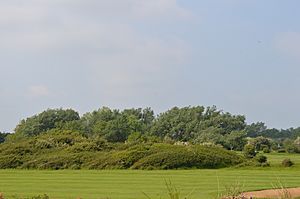Clacton Cliffs and Foreshore facts for kids
| Site of Special Scientific Interest | |

The site in Clacton Golf Course
|
|
| Area of Search | Essex |
|---|---|
| Grid reference | |
| Interest | Geological |
| Area | 26.1 hectares |
| Notification | 1986 |
| Location map | Magic Map |
Clacton Cliffs and Foreshore is a special place in Clacton-on-Sea, Essex, England. It's a protected area because of its amazing geology. This means it has very old rocks and soil that tell us about Earth's past.
The site covers about 26 hectares, which is like 36 football fields! It was officially recognized as a Site of Special Scientific Interest (SSSI) in 1986. This protection helps keep the area safe for scientists to study and for future generations to learn from.
Contents
What Makes This Place Special?
This site is super important for understanding Earth's history. Scientists say it has some of the most important deposits from a time called the Pleistocene period. This was a long time ago, often called the Ice Age.
Ancient Warm Periods
The deposits at Clacton Cliffs and Foreshore come from a warm period within the Ice Age, known as the Hoxnian Stage. This stage happened about 400,000 years ago! Imagine how old that is – long before dinosaurs, but still incredibly ancient. During this time, the climate was much warmer than it is today.
Discovering Ancient Tools
In the early 1900s, scientists found something incredible here: ancient flint tools. These tools were made by early human ancestors. Because so many unique tools were found here, Clacton Cliffs and Foreshore became a "type site." This means it's the main place where a specific type of ancient tool-making was first identified.
The Clactonian Toolmakers
The tools found here belong to what scientists call the Clactonian culture. These tools were made by a type of early human called Homo erectus. They used a simple method: they would hit a large stone (the core) with another stone to chip off sharp pieces (flakes). These flakes were then used as knives, scrapers, or other tools.
Scientists are still discussing if the Clactonian tools are truly different from another type of ancient tools called the Acheulian. But either way, finding these tools helps us learn about how early humans lived and survived so long ago.
Visiting the Site
The Clacton Cliffs and Foreshore site is split into three different areas. Two of these areas are along the shoreline footpath, which you can walk on. However, you can't see the important geological layers from these parts.
The third area is inside the Clacton Golf Course. This part of the site is not open to the public. This helps protect the sensitive geological features and ancient discoveries found there.

